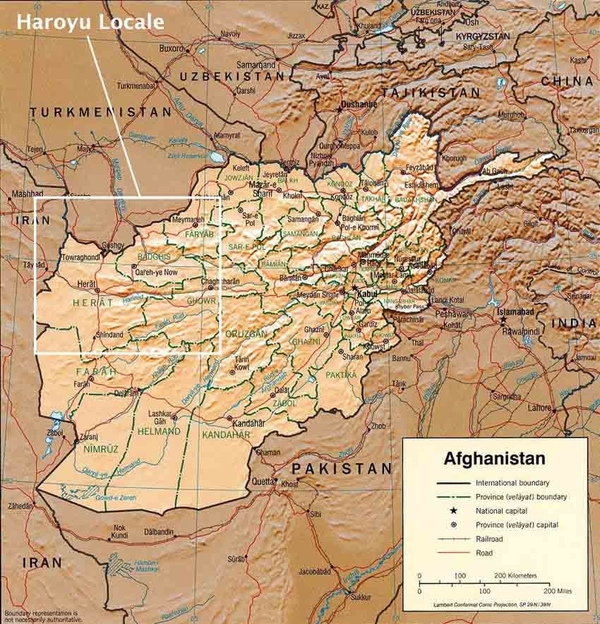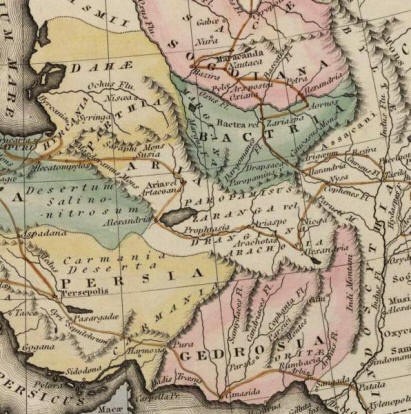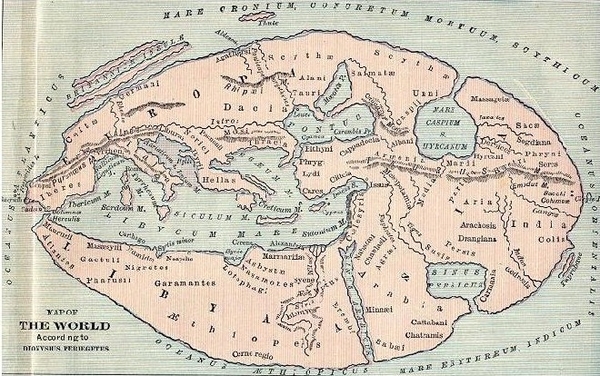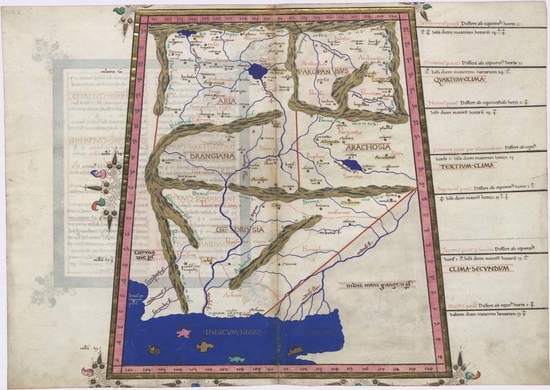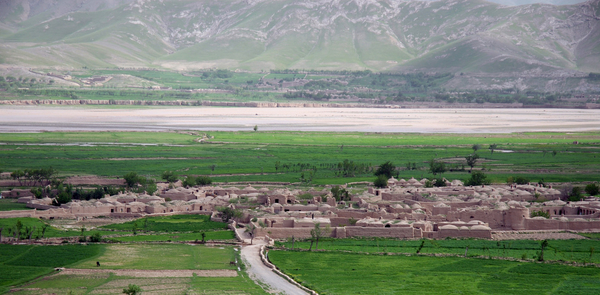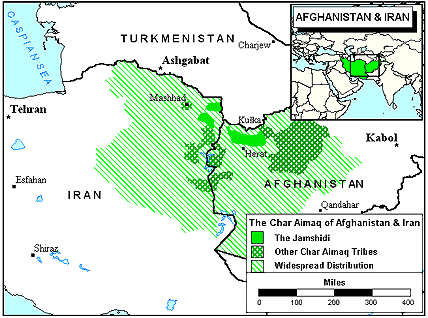
| HAROYU Haroyu
:
Haroyu is commonly identified with the lands surrounding the Hari Rud River in north-western Afghanistan, bordered in the east by Bakhdhi (Balkh), to the north by Mouru (Merv) and Nisaya (Nisa) in today's Turkmenistan, to the west by Urva (Khorasan) and to the south by Haetumant (Helmand and Siestan / Sistan) as well as Harahvaiti (Kandahar). To locate these nations, please see our map on the Nations of the Vendidad.
This list of nations does not mention Persia and Media and was possibly complied before 800 BCE.
Relief map of Afghanistan, 2003 showing the region of Lesser Aria - present day Herat Province in Afghanistan Aria
:
The past legacy and greatest of Aria and its prominence amongst the nations of the Persian Empire are evident when viewing Ptolemy's map of the world. In Ptolemy's map of the world, Aria's name in larger letters stands out in relation to those of its neighbours.
Arrian (c.87-145 CE) in Anabasis 4.6.6 states that in antiquity, Aria was considered as particularly fertile and rich in wine. Thus reference by Arrian to Aria having been particularly fertile in antiquity may refer to the memory of Aria's predecessor nation, Airyana Vaeja (see above), being very fertile and a paradise on earth. Herodotus described Aria as the bread-basket of Central Asia.
The classical writers called Aria's capital, Artacoana (also spelt Artacana, Articaudna, Chortacana, and Artacaena), a city destroyed by Alexander. Close to the destroyed capital of Artacoana, Alexander built another city, Alexandria Ariana, which he named after himself. Alexandria Ariana is identified as modern-day Herat in north-western Afghanistan.
Classical Maps & Aria's Location :
Map of the world based on the descriptions of Dionysius c. 405 BCE.
Note Aria adjacent to the northern Indus River and the 'Taurus'
mountain range extending from Cappadocia to northern India.
Reconstruction of Ptolemy's map of another version of Lesser Aria and neighbouring states that were part of Great Aria 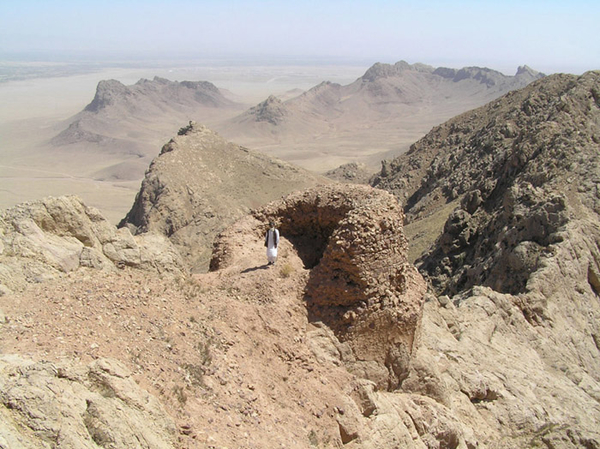
View from Kafar / Issar Qala at to the Hari Rud and the oasis of Herat
Ancient Herat city was destroyed by Alexander of Macedonia. Photo
credit: Deutsches Archaologisches Institut.
After the Achaemenian dynasty was overthrown by Alexander of Macedonia in 330 BCE, he advanced east toward the heartland of the Aryan lands. The route he choose was to march upon Haraiva / Aria, destroying its historic capital Artacoana (also spelt Artacana, Articaudna, Chortacana, and Artacaena) and selling its inhabitants as slaves. After Alexander had advanced into Sugd, Aria rose up in revolt which Alexander managed to suppress. Nevertheless, the unrest in Aria continued for a couple of years causing Alexander to divert troops and resources.
Sassanian Khurasan :
Herat :
Herat province is formed around the valley of Hari Rud River which flows to the Kara Kum Desert in Turkmenistan. Since this river starts in the province of Ghowr, Haroyu may have been included Ghowr.
Today, Herat while naturally beautiful in many ways, may not fit the descriptions of Airyana Vaeja in the Avesta. Poor conservation methods and devastating through years of war have resulted in poverty and a destruction of the environment. There are natural pistachio forests in the Koshk-e Kohna district, which during past twenty years have been indiscriminately cut for fuel. An example of some of Herat's natural assets are the number of medicinal plants such as liquorice and black cumin that can be found in the lands surrounding Herat city.
Parsiban / Farsiwan :
The Parsiban are also often called Dehgan, Dehgan or Dehqan, variations of a word that has now come to mean landed, village settlers, urban and even farmer. It probably means someone who is not nomadic but settled - someone who is attached to the land, whether urban or rural. Ferdowsi, author of the epic Shahnameh, was a Dehqan and therefore a Parsi or Parsiban.
This terminology may have significance for the Parsi of India as there are indications that some of the Parsi Zoroastrian immigrants to India originated from Khorasan or travelled via Khorasan. In those days - a thousand years ago - Khorasan included a large part of Eastern Iran and Western Afghanistan.
Since Parsi fundamentally means 'of Pars' or 'from Pars', and since Pars is now a south-western province of Iran, we may conclude that the name Parsi indicates an origin in Pars. In other words, we may be led to conclude that the Khorasani Parsi originally came from Pars. However, since the Khorasani Parsi are ethnic Tajiks, there is no reason why the opposite cannot be true. In this scenario, the Parsi would have originated in the eastern Aryan lands from where they would have migrated west through Haroyu and Khorasan, eventually settling in the Elamite lands they would call Parsa or Pars.
Parsii :
William Woodthorpe Tarn in The Greeks in Bactria and India states, "No one has really considered Apollodorus' fourth people, the Pasiani, who happen to be important, for it was they who a century later put an end to Greek rule in India. As Asiani is the Iranian adjectival form of Asii, so Pasiani would be the adjectival form of the name Pasi or Pasii; and there can be no doubt that this name is the Parsii (Parsioi) of Greek geographers. For the same stem occurs again in southern Iran, and the known Greek variants on the word Pasargadae (the usual form in Greek writers), namely Passagadae and Parsagadae, make the equivalence Pasi-Parsii certain; they may also suggest that the word Parsii was really not Saca but Persian. The adjectival form of Parsii occurs again, alongside of the substantial form, in the names of the villages Parsia and Parsiana in Ptolemy (p. 331), Parsiana being identical with Pasiani.
[Note: The Chinese Po-sse for Persia (Parsa) would imply a form Pasi, were it not fifth-century A.D. and too late to use. But the Greek form Passagadae, used by an Alexander-historian of the fourth century B.C., removes any objection; and indeed it is possible that Po-sse in the Wei-shu may mean not Persia but the Parsii. The certain equivalent Pasi-Parsii therefore guarantees Asii-Arsi, which in view of Pliny (p.285) may still be required.]
"As a place has to be found for the Parsii in the Bactrian kingdom, and as the Yueh-chi and the Sacaraucae between them account for Bactria proper, southern Sogdiana, and Merv, the only possible locality for the Parsii is farther to the west; their first conquest must have been the one-time Bactrian satrapies west of the Arius, Tapuria and Traxiane, that is, a large part of what had once been the kingdom of Antimachus, assuming that Merv, from its geographical position, must have fallen to the Sacaraucae from Bokhara. This would explain why Apollodorus named the Parsii among the conquerors of the Bactrian kingdom while 'Trogus' source' seemingly did not; Tapuria and Traxiane had long been Bactrian but were no longer so at the date of the Yueh-chi conquest, having been taken from Eucratides by Mithridates I (p. 2.19), and so it was possible for two well-informed writers to take different views about them; 'Trogus' source' must have reckoned the Parsii among the invaders of Parthia.
"Who were these Parsii? The word seems to be the Old Persian Parsua which means Persians. The Persians of Persis called themselves Parsa; but the form Parsua is old-it has been suggested that it was the Median form of Parsa - and had already played a part in the history of the Iranian invasions as the name of a people who had reached northeast Iran and south Armenia and appear in Assyrian records; of the known original Iranian tribes they belonged to the Parsa-Parsua Persian tribe. The Parsii of Apollodorus and Ptolemy, then, were a branch of the Persian people who had remained behind when their kinsfolk went south. But if they remained behind, where did they live? In Persian tradition the original Iranian 'home', that is, the centre from which the Iranian peoples set out on their conquests to the southward, was called Eranvej, and Eranvej has recently been identified with Chorasmia (Kwarizm). Now Kwarizm, sandwiched between the Sacaraucae and the Massagetae, is too important a country not to have played some part in the second-century invasions."
The Hari Rud, its valley and a village in Herat province, Afghanistan. Photo credit; funnybear at Flickr Char Aimaq & Jamshidi :
Map showing location of Jamshidi-Aimaq people in Afghanistan In Herat province - modern-day Aria - as well as in neighbouring provinces in Afghanistan and Iran, are a group of people called Char Aimaq or Chahar Eimaka meaning four tribes, Char / Chahar being a Persian word while Aimaq / Eimaka is a Mongolian word. The four tribes are the Taimani, Firozkohi, Timuri and Jamshidi. The Jamshidi get their name from the legendary Aryan King Jamshid. Firozkohi name derives from firuz-kuh, meaning "mountain of turquoise." The Aimaq language dialects resemble Dari (Afghan eastern Farsi) mixed with words of Mongolian and Turkic origin.
The four tribes are in turn made up of 250 sub-tribes. Known for their formidable warrior skills, while the Char Aimaq have not united politically, they have formed alliances for mutual protection against invaders. Amazingly, the Jamshidi Aimaq who represent the cultural integration of Aryan, Turkic and Mongolian features - a product of centuries of mixing at the cross-roads of history - continue to claim a link to legendary King Jamshid.
The Aimaq are mainly employed in agriculture (cultivating rice, cotton, grapes, wheat and melons) as well as in animal husbandry and live principally in Badghis, Ghor and Herat Provinces. Aimaq food is mainly whole wheat nan bread baked in mud ovens, rice, chickpeas, potatoes, summer garden vegetables, chicken, and eggs. Lamb is served special occasions and to guests. Dugh made with yogurt, salt, pepper and water is the beverage of choice.
Their principal (capital) city is Chaghcharan close to the ancient city of Herat. The largest number of the Jamshidi and Timuri live in the fertile Kush River valley northeast of Herat city in Herat and Badghis Provinces. Another significant group of Jamshidi live in the northeast of Iran's Khorasan province, south of Mashhad. The main Aimaq city. Mashhad The Taimani and Firozkohi tribes for the main part live in the mountainous and largely barren Ghor Province's, living respectively in the Hari Rud and Murghab River valleys. There they endure severe winters and poor rainfall. During periods of drought (which are fairly regular in the region) virgins are reputedly called upon to perform pre-Islamic rain dances. The semi-nomadic and poorer Taimani and Firozkohi tribes living in less fertile areas of Badghis Province, cultivate wheat, melons and fodder to feed animals that must be stabled in winter. When moving their flocks in summer, the Firozkohi dwell in traditional yurts. The borders between Iran, Afghanistan and Turkmenistan have little meaning to the nomadic groups.
Group affiliations amongst the Aimaq are based on the clan and extended family. Group leadership is male and the Aimaq trace their ancestry through male lines. Amongst the Timuri and Jamshidi, marriages often take place between blood relatives, where the female is between 13 and 14 years of age and the male between 16-20 years of age. However, among the Taimani and Firozkohi, females marry around 18 years of age and have the option of rejecting their parent's choice of husband.
Source :
http://www.heritageinstitute.com/ |
